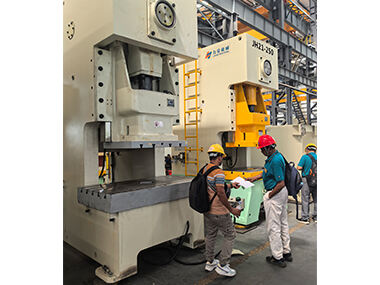உற்பத்தியில் திறமை, துல்லியம் மற்றும் பாதுகாப்பை நாடுவது உழைக்கிறது மற்றும் தொழில்துறை துறையை மாற்றுகிறது. தகடு உலோகத் துறையிலும், பகுதிகள் உற்பத்தியிலும் ஒரு அமைதியான புரட்சி நடந்து வருகிறது: பாரம்பரிய மற்றும் இயந்திர பிரஸ்களை மாற்றும் வகையில் புதையுந்து பஞ்ச் பிரஸ்களின் மெல்லிய அதிகரிப்பு. இந்த மாற்றத்திற்கு பின்னால் உள்ள காரணங்கள் வலுவானவை, செயல்பாடுகளின் சில உண்மையான நன்மைகளை அடிப்படையாகக் கொண்டவை.
1.ஒப்பிட முடியாத துல்லியம் மற்றும் கட்டுப்பாடு: பாரம்பரிய அச்சு பொதுவாக சக்கரம் மற்றும் சிக்கலான கிளட்ச்/பிரேக் அமைப்புகளை உபயோகித்து சக்தியை வழங்குகிறது, ஆனால் ஸ்ட்ரோக்கை கண்ட்ரோல் செய்வதில் முறையான துல்லியமும் குறைவாகவே இருக்கும். மின்சாரத்தால் இயங்கும் அச்சுகள், கட்டுப்படுத்தப்பட்ட காற்றழுத்தத்தால் இயங்கும் புனைமிக்க அச்சுகள் அசாதாரணமாக துல்லியமானவை. டன்னேஜ் மற்றும் ஸ்ட்ரோக்குகளை டிஜிட்டல் முறையில் கட்டுப்படுத்துவது ஆபரேட்டர்கள் இந்த அளவுகோல்களை எளிதாக சரி செய்ய உதவுகிறது, இதனால் பஞ்சிங் செயல்முறை முழுவதும் ஒரே மாதிரியான விசை பயன்படுத்தப்படுகிறது. இது பழைய இயந்திர அமைப்புகளில் உள்ள தவறுகளை தவிர்க்கிறது, இதன் விளைவாக முடிக்கப்பட்ட பாகங்களின் தரம் மேம்படுகிறது, துல்லியமான அளவுகள் பெறப்படுகின்றன மற்றும் தொலைப்பு நிலைகள் குறிப்பிடத்தக்க அளவில் குறைகின்றன, இது நவீன அதிக துல்லிய உற்பத்திக்கு அவசியமானது.
2. குறிப்பிடத்தக்க அதிகரிப்பு வேகம் மற்றும் செயல்திறன்: செயல்திறன் வேகத்துடன் ஒன்றாகும். இதில், புத்திசாலித்தனமான பஞ்ச் அழுத்தங்கள் சிறப்பாக உள்ளன. பாரம்பரிய அழுத்தங்களுடன் ஒப்பிடும்போது மிக அதிக சுழற்சி வேகங்களை அவற்றின் அமைப்பு அனுமதிக்கிறது. ஃப்ளைவீல்கள் போன்ற கனமான சுழலும் நிறைகள் முடுக்கத்திற்கும், மெதுவாக்கத்திற்கும் இல்லை. பஞ்சிங் ஒரு வினாடிக்கு பின்னமாக மேற்கொள்ளப்படலாம், இது மிகவும் அதிக உற்பத்தி திறனை அதிகரிக்கிறது. மேலும், புத்திசாலித்தனமான அமைப்பின் எளிமை மிகக் குறுகிய தொகுப்பு மற்றும் மாற்று நேரங்களை அனுமதிக்கிறது, இது இயந்திர பயன்பாட்டையும், மொத்த உபகரணங்களின் செயல்திறனையும் (OEE) அதிகபட்சமாக்குகிறது.
3. உள்ளார்ந்த பாதுகாப்பு நன்மைகள்: பாதுகாப்பே முதன்மை கவலையாக இருக்க வேண்டும். குறிப்பாக, வெளிப்படையான பறக்கும் சக்கரங்கள் அல்லது பல-பகுதி பிரேக் இயந்திரங்களைக் கொண்டவை போன்ற பாரம்பரிய அழுத்திகளுக்கு ஆபத்து உண்டு. அவை நிறுத்துவது கடினமாக இருப்பதால், அவசர சூழ்நிலை அல்லது சிக்கல் ஏற்பட்டால் பணி கடினமாக இருக்கலாம். காற்றழுத்த அழுத்திகளுக்கு உள்ள சில பாதுகாப்பு நன்மைகள் உள்ளார்ந்தவை. ஒளி திரைகள் அல்லது இரு-கை கட்டுப்பாடுகள் போன்ற பாதுகாப்பு சாதனங்கள் செயல்படுத்தப்படும் போது, காற்று அழுத்தத்தை கிட்டத்தட்ட கணம் காலத்தில் வெளியிட்டு, ராம் இயக்கத்தை நிறுத்த முடியும். இதுபோன்ற விரைவான செயல், தவறான செயல்பாடு அல்லது எதிர்பாராத பயன்பாட்டின் போது ஆபரேட்டர்களுக்கு ஏற்படும் காயங்களின் நிகழ்தகவை மிகவும் குறைக்கிறது. குறைந்த இயந்திரங்கள் என்பது பாரம்பரிய வடிவமைப்பை விட குறைந்த குச்சிப்புள்ளிகளை குறிக்கிறது.
4.குறைக்கப்பட்ட பராமரிப்பு மற்றும் இயக்க செலவுகள்: பாரம்பரிய அச்சுகள் இயந்திர ரீதியாக மிகவும் சிக்கலானவை, எனவே அவற்றை பராமரிக்க சுருக்கி, கிளட்ச்/பிரேக்கை சரிசெய்தல், பெயரிங்கை மாற்றுதல் மற்றும் பறப்புச்சக்கரத்தில் ஏற்படக்கூடிய சிக்கல்களுக்காக அடிக்கடி மற்றும் பல சந்தர்ப்பங்களில் செலவு செய்ய வேண்டியிருக்கும். இயல்பாகவே, காற்றழுத்த அச்சுகளில் மிகக் குறைந்த அளவே இயங்கும் பாகங்கள் உள்ளன, எனவே அவை குறைந்த அளவிலான தேய்மானத்தை அனுபவிக்கின்றன. அவை பராமரிக்கப்பட வேண்டும் (வடிகட்டிகள், சுருக்கிகள்) என்றாலும், சிக்கலான இயந்திர இயக்கங்கள் மற்றும் பிரேக் அமைப்புகளை ஒப்பிடும்போது காற்று அமைப்புகள் பராமரிக்க ஒப்பீட்டளவில் எளிதானவை, குறைந்த அளவே தேவைப்படுபவை மற்றும் குறைந்த செலவுள்ளவை. துளையிடும் ஓட்டத்தின் போது ஆற்றல் நுகர்வு அதிகமாக இருக்கும் காற்றழுத்த அமைப்பை ஒப்பிடும்போது, எப்போதும் சுழலும் பறப்புச்சக்கர அமைப்பை விட குறைந்த ஆற்றலை பயன்படுத்த முடியும்.
5. சிறந்த நெகிழ்வுத்தன்மை மற்றும் நிரலாக்கத் திறன்: தற்போதைய உற்பத்தி சார்ந்த தேவைகள் மாற்றத்திற்கு ஏற்ப செயல்படுவதை நோக்கமாகக் கொண்டுள்ளன. பினியூமாடிக் பிரஸ்களை எளிதாக புரோகிராமபில் செய்யக்கூடிய லாஜிக் கன்ட்ரோலர்கள் (PLCs), மற்றும் தானியங்கி அமைப்புகளுடன் ஒருங்கிணைக்க முடியும். பல்வேறு பணி சார்ந்த செயல்திறன்கள் (டன்னேஜ், ஸ்ட்ரோக் ஆழம், வேகம்) ஆபரேட்டர்களால் சேமிக்கப்பட்டு, கணம் கணத்தில் மீண்டும் பயன்படுத்தப்படலாம். இந்த நெகிழ்வான திட்டமிடல் வெவ்வேறு பொருட்கள் மற்றும் பாகங்களின் வடிவவியலுக்கு எளிதாக மாற உதவுகிறது, எனவே அதிக கலவை, குறைந்த அளவு உற்பத்தி செயல்முறைகளில் அல்லது குறிப்பிட்ட அதிக அளவு உற்பத்தி பயன்பாடுகளில் கூட இது சிறப்பாக செயல்படுகிறது. இயல்பாகவே உள்ள கட்டுப்பாட்டுத்திறன் நிப்பிளிங் மற்றும் வடிவமைத்தல் போன்ற சிறப்பு செயல்பாடுகளை மேலும் துல்லியமாக செய்வதை சாத்தியமாக்குகிறது.
6. குறைந்த சத்தம் மற்றும் அதிர்வு: பாரம்பரியமாக, இயந்திர அழுத்திகளின் செயல்பாட்டு செயல்முறை அதிக அளவு சத்தம் மற்றும் அதிர்வுகளால் குறிப்பிடப்படுகிறது, இது ஆபரேட்டரின் சோர்வை ஏற்படுத்துகிறது மற்றும் கூடுதல் ஈடுசெய்யும் பரிந்துரைகளை தேவைப்படுத்துகிறது. தரநிலை வாயு அழுத்திகள் மிகவும் அமைதியாக இருக்கும் மற்றும் மிகக் குறைந்த அதிர்வுகளை உருவாக்கும். இது ஒரு வசதியான பணி சூழலை உருவாக்கும், குறைந்த சத்தம் மாசுபாட்டை ஏற்படுத்தும், மற்ற உபகரணங்கள் அல்லது தொழிற்சாலைக்கே அதிர்வு தொடர்பான பிரச்சினைகளை குறைக்கும்.
எதிர்காலம் காற்றால் இயங்குவதாகும்
பாரம்பரிய அழுத்தங்கள் தொழிலுக்கு தசாப்தங்களாக சேவை செய்தாலும், துல்லியம், வேகம், பாதுகாப்பு மற்றும் நெகிழ்வுத்தன்மை ஆகியவற்றில் அவை கொண்டுள்ள குறைபாடுகள் தற்கால உற்பத்தியின் புதிய தேவைகளுடன் ஒப்பிடும்போது மிகவும் கவனிக்கத்தக்கவையாக மாறிவருகின்றன. காற்றழுத்த பஞ்ச் பிரஸ்கள் இந்த குறைபாடுகளை மையமாகக் கொண்டுள்ளன. அதிக துல்லியம், அதிக வேகம், மேம்பட்ட பாதுகாப்பு, குறைந்த செயல்பாட்டு செலவுகள், சிறந்த நெகிழ்வுத்தன்மை மற்றும் அமைதியான செயல்பாடு ஆகியவற்றின் சிறந்த தொகுப்பை தொழில்துறை உற்பத்தியாளர்களுக்கு வழங்குகின்றன. தொழில்கள் பணியிடங்களில் திறமை, தரம் மற்றும் பாதுகாப்பில் அதிகம் கவனம் செலுத்தும் போக்கை கொண்டுள்ளன. எனவே காற்றழுத்த தொழில்நுட்பம் தனது உறுதிப்படுத்தப்பட்ட தரங்கள், பண்புகள் மற்றும் திறன்களை நியாயப்படுத்துகிறது. இது ஒரு சாத்தியமான மாற்று தீர்வு மட்டுமல்ல, தொழிற்சாலை தளத்தில் விரைவில் பாரம்பரிய அழுத்தங்களை மாற்றி அமைக்கப்போகும் தெளிவான தொடர்ச்சியாகவும் உள்ளது. இந்த மாற்றம் ஏற்கனவே தொடங்கிவிட்டது. காற்றழுத்த பஞ்ச் பிரஸ்கள் மறுக்க முடியாத செயல்பாட்டு நன்மைகளை வழங்குவதால் இந்த மாற்றம் ஊக்குவிக்கப்படுகிறது.


